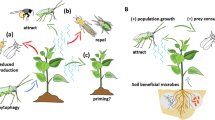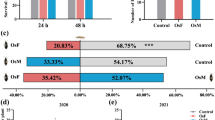Abstract
Zoophytophagous insects can feed on a variety of prey, plants and plant products. By studying the interactions between predatory hemipterans and plants harbouring the prey of these insects, scientists have started to establish two potential outcomes: (1) positive effects like the enhancement of their life history characteristics by acquiring plant contents; and (2) negative effects mediated by plant resistance to herbivores or prey ingesting secondary plant metabolites. Despite this research, there is a lack of information about the feeding sites of predatory hemipterans on their host plants, what they ingest from plants, and whether they cause damage to their host plants. The results presented here indicate that the xylem is one of the feeding sites of predatory hemipterans on plants. The dissection of predators that fed on plants with marked vessels and testing insects for the presence of Cry protein constitutively expressed in the cytoplasm of plant cells revealed that bugs are not able to acquire cytoplasm contents from the plant cell. In addition, we demonstrate that systemic insecticide circulating inside plants from soil applications contaminates these predators. Our results are discussed in the context of zoophytophagous feeding behaviour exhibited by predatory hemipterans and the use of systemic insecticides for the conservation of natural enemies. This interaction contradicts the concept of ecological selectivity obtained for natural enemies through the placement of systemic insecticide in the soil as a selective method of deploying chemical control and predatory hemipteran conservation within the integrated pest management framework.




Similar content being viewed by others
References
Arim M, Pablo AM (2004) Intraguild predation: a widespread interaction related to species biology. Ecol Let 7:557–564
Armer CA, Wiedenmann RN, Bush DR (1998) Plant feeding site selection on soybean by the facultatively phytophagous predador Orius insidiosus. Entomol Exp Appl 86:109–118
Azevedo DO, Zanuncio JC, Zanuncio Junior JS, Martins GF, Marques-Silva S, Sossai MF, Serrão JE (2007) Biochemical and morphological aspects of salivary glands of the predator Brontocoris tabidus (Heteroptera: Pentatomidae). Braz Arch Biol Technol 50:469–477
Boyd DW Jr, Cohen AC, Alverson DR (2002) Digestive enzymes and stylet morphology of Deraeocoris nebulosus (Hemiptera: Miridae), a predacious plant bug. Ann Entomol Soc Am 95:395–401
Brodbeck BV, Mizell RF III, French WJ, Andersen PC, Aldrich JH (1990) Amino acids as determinants of host preference for the xylem feeding leafhopper, Homalodisca coagulata (Homoptera: Cicadellidae). Oecologia 83:388–395
Brown GC, Shanks CH (1976) Mortality of two spotted spider-mite (Acarina-Tetranychidae) predators caused by systemic insecticide, carbofuran. Environ Entomol 5:1155–1159
Cock A, De Clercq P, Tirry L, Degheele D (1996) Toxicity of diafenthiuron and imidacloprid to the predatory bug Podisus maculiventris (Heteroptera: Pentatomidae). Environ Entomol 25:476–480
Coelho RR, Araujo Júnior JM, Torres JB (2008) Comportamento de predação de Podisus nigrispinus (Dallas, 1851) (Hemiptera: Pentatomidae) em função da disponibilidade de alimento. Arq Inst Biol 75:463–470
Coelho RR, Veiga AFSL, Torres JB (2009) Preferência alimentar e desempenho de Brontocoris tabidus Signoret (Hemiptera, Pentatomidae) em plantas hospedeiras. Rev Bras Entomol 53:475–481
Cohen AC (1998) Solid-to-liquid feeding: the inside story of extra-oral digestion in predaceous arthropoda. Am Entomol 44:103–115
Cohen AC, Wheeler AG (1998) The role of saliva in the highly destructive fourlined plant bug (Hemiptera: Miridae: Mirinae). Ann Entomol Soc Am 91:94–100
Coll M (1998) Living and feeding on plants in predatory Heteroptera. In: Coll M, Ruberson JR (eds) Predatory Heteroptera: their ecology and use in biological control. Entomological Society of America, Lanham, pp 89–129
Coll M, Guershon M (2002) Omnivory in terrestrial arthropods: mixing plant and prey diets. Ann Rev Entomol 47:267–297
Evangelista Junior WS, Gondim Junior MGC, Torres JB, Marques EJ (2004) Fitofagia de Podisus nigrispinus em algodoeiro e plantas daninhas. Pesq Agropec Bras 39:413–420
Eveleens KG, Van den Bosch R, Ehler LE (1973) Secondary outbreak induction of beet armyworm by experimental insecticide applications in cotton in California. Environ Entomol 2:497–503
Fox LR (1975) Cannibalism in natural populations. Annu Rev Ecol Syst 6:87–106
Gerling D, Mayer RT (1996) Bemisia: 1995 Taxonomy, biology, damage, control and management. Intercept, Andover
Giaquinta RT (1983) Phloem loading of sucrose. Annu Rev Plant Physiol 34:347–387
Gillespie DR, McGregor RR (2000) The functions of plant feeding in the omnivorous predator Dicyphus hesperus: water places limits on predation. Ecol Entomol 25:380–386
Goodchild AJP (1966) Evolution of the alimentary canal in the Hemiptera. Biol Res 41:97–140
Hagerty AM, Kilpatrick AL, Turnipseed SG, Sullivan MJ, Bridges WC (2005) Predaceous arthropods and lepidopteran pests on conventional, Bollgard, and Bollgard II cotton under untreated and disrupted conditions. Environ Entomol 34:105–114
Holling CS (1959) Some characteristics of simple types of predation and parasitism. Can Entomol 91:293–320
Hori K (2000) Possible causes of disease symptoms resulting from the feeding of phytophagous Heteroptera. In: Schaefer CW, Panizzi AR (eds) Heteroptera of economic importance. CRC Press, Boca Raton, pp 11–35
Hull LA, Beers EH (1985) Ecological selectivity: modifying chemical control practices to preserve natural enemies. In: Hoy MA, Herzog DC (eds) Biological control in agricultural IPM systems. Academic Press, New York, pp 103–122
Hunter WB, Backus EA (1989) Mesophyll-feeding by the potato leafhopper, Empoasca fabae (Homoptera: Cicadellidae): results from electronic monitoring and thin-layer chromatrography. Environ Entomol 18:465–472
Jervis MA, Kidd NAC (1996) Phytophagy. In: Jervis MA, Kidd NAC (eds) Insect natural enemies: practical approach to their study and evolution. Chapman & Hall, London, pp 375–394
Johansen DA (1940) Plant microtechnique. Paul B. Hoeber Inc, New York
Legaspi JC, O’Neil RJ (1993) Life history of Podisus maculiventris given low numbers of Epilachna varivestis as prey. Environ Entomol 22:1192–1200
Lundgren JG (2009) Relationships of natural enemies and non-prey foods. Progress in biological control, vol 7. Springer, New York
Marschner H (1995) Mineral nutrition of higher plants. Academic Press, San Diego
Matos Neto FC, Zanuncio JC, Cruz I, Torres JB (2002) Nymphal development of Podisus nigrispinus (Heteroptera, Pentatomidae) preying on larvae of Anticarsia gemmatalis (Lepidoptera, Noctuidae) fed with resistant and susceptible soybeans. Rev Bras Entomol 46:237–241
Nakashima Y, Hirose Y (1999) Effects of prey availability on longevity, prey consumption, and egg production of the insect predators Orius sauteri and O. tantillus (Hemiptera: Anthocoridae). Anna Entomol Soc Am 92:537–541
Oliveira EJM, Torres JB, Carrano-Moreira AF, Ramalho FS (2002) Biologia de Podisus nigrispinus predando lagartas de Alabama argillacea em campo. Pesq Agropec Bras 37:7–14
Oliveira JA, Oliveira MGA, Guedes RNC, Soares MJ (2006) Morphology and preliminary enzyme characterization of the salivary glands from the predatory bug Podisus nigrispinus (Heteroptera: Pentatomidae). Bull Entomol Res 96:251–258
Papachristos DP, Milonas PG (2008) Adverse effects of soil applied insecticides on the predatory coccinellid Hippodamia undecimnotata (Coleoptera: Coccinellidae). Biol Control 47:77–81
Pate JS, Sharkey PJ, Lewis OAM (1975) Xylem to phloem transfer of solutes in fruiting shoots of legumes, studied by a phloem bleeding technique. Planta 122:11–26
Perring TM, Gruenhagen NM, Farrar CA (1999) Management of plant viral diseases through chemical control of insect vectors. Annu Rev Entomol 44:457–481
Purcell JP, Oppenhuizen M, Wofford T, Reed AJ, Perlak FJ (2004) The story of Bollgard cotton. In: Christou P, Klee H (eds) Handbook of plant biotechnology. Wiley, Indianapolis, pp 1147–1163
Raps A, Kehr J, Gugerli P, Moar WJ, Bigler F, Hilbeck A (2001) Immunological analysis of phloem sap of Bacillus thuringiensis corn and of the nontarget herbivore Rhopalosiphum padi (Homoptera: Aphididae) for the presence of Cry1Ab. Mol Ecol 10:525–533
Ridgway RL, Lingren PD, Cowan CB, Davis JW (1967) Populations of arthropod predators and Heliothis spp. after applications of systemic insecticides to cotton. J Econ Entomol 60:1012–1016
Rosenheim JA, Wilhoit LR, Amer CA (1993) Influence of intraguild predation among generalist insect predators on the suppression of an herbivore population. Oecologia 96:439–449
Ruberson JR, Tauber MJ, Tauber CA (1986) Plant feeding by Podisus maculiventris (Heteroptera: Pentatomidae): effect on survival, development, and preoviposition period. Environ Entomol 15:894–897
Rudolf VHW (2007) The interactions of cannibalism and omnivory: consequences for community dynamics. Ecology 88:2697–2705
Sanchez JA, Gillespie DR, McGregor RR (2004) Plant preference in relation to life history traits in the zoophytophagous predator Dicyphus hesperus. Entomol Exp Appl 112:7–19
Smith SF, Krischik VA (1999) Effects of systemic imidacloprid on Coleomegilla maculata (Coleoptera: Coccinellidae). Environ Entomol 28:1189–1195
Stamopoulos DC, Diamantidis C, Chloridis A (1993) Activités enzymatiques du tube digestif du prédateur Podisus maculiventris (Hem.: Pentatomidae). Entomophaga 38:493–499
Stamp NE, Yang Y, Osier TL (1997) Response of an insect predator to prey fed multiple allelochemicals under representative thermal regimes. Ecology 78:203–214
Stapel JO, Cortesero AM, Lewis WJ (2000) Disruptive sublethal effects of insecticides on biological control: altered foraging ability and life span of a parasitoid after feeding on extrafloral nectar of cotton treated with systemic insecticides. Biol Control 17:243–249
Stoner A (1970) Plant feeding by a predaceous insect, Geocoris punctipes. J Econ Entomol 63:1911–1915
Terra WR, Ferreira C (1994) Insect digestive enzymes: properties, compartmentalization and function. Comp Biochem Physiol B 109:1–62
Torres JB, Boyd D Jr (2009) Zoophytophagy in predatory Hemiptera. Braz Arch Biol Technol 52:1199–1208
Torres JB, Ruberson JR (2004) Toxicity of thiamethoxam and imidacloprid to Podisus nigrispinus (Dallas) (Heteroptera: Pentatomidae) nymphs associated to aphid and whitefly control in cotton. Neotrop Entomol 33:99–106
Torres JB, Ruberson JR (2008) Interactions of Bacillus thuringiensis Cry1Ac toxin in genetically engineered cotton with predatory heteropterans. Transg Res 17:345–354
Torres JB, Silva-Torres CSA (2008) Interação entre inseticidas e umidade do solo no controle do pulgão e da mosca-branca em algodoeiro. Pesq Agropec Bras 43:949–956
Torres JB, Silva-Torres CSA, Barros R (2003) Relative effects of the insecticide thiamethoxam on the predator Podisus nigrispinus and the tobacco whitefly Bemisia tabaci in nectaried and nectariless cotton. Pest Manage Sci 59:315–323
Torres JB, Zanuncio JC, Moura MA (2006a) The predatory stinkbug Podisus nigrispinus: biology, ecology and augmentative releases for lepidopteran larval control in Eucalyptus forests in Brazil. CAB Rev: Persp AgricVet Sci 15:1–18
Torres JB, Ruberson JR, Adang MJ (2006b) Expression of Bacillus thuringiensis Cry1Ac protein in cotton plants, acquisition by pests and predators: a tritrophic analysis. Agric For Entomol 8:191–202
Wäckers FW, Romeis J, van Rijn P (2007) Nectar and pollen feeding by insect herbivores and implications for multitrophic interactions. Annu Rev Entomol 52:301–323
Zeng F, Cohen AC (2000) Comparison of α-amylase and proteinase activities of a zoophytophagous and two phytozoophagous Heteroptera. Comp Biochem Physiol A 126:101–106
Acknowledgments
We thank Robério C.S. Neves for providing the predators, and the two anonymous reviewers and the editor for their valuable comments and corrections. This work was supported by a CNPq research grant to J.B.T., by a CNPq graduate grant to E.M.B. and by a CAPES graduate grant to R.R.C. The reported results belong to a broad project aimed at integrating predators into IPM, which is funded by the agencies FACEPE and FINEP.
Author information
Authors and Affiliations
Corresponding author
Additional information
Handling Editor: Stanislav Gorb.
Rights and permissions
About this article
Cite this article
Torres, J.B., Barros, E.M., Coelho, R.R. et al. Zoophytophagous pentatomids feeding on plants and implications for biological control. Arthropod-Plant Interactions 4, 219–227 (2010). https://doi.org/10.1007/s11829-010-9095-2
Received:
Accepted:
Published:
Issue Date:
DOI: https://doi.org/10.1007/s11829-010-9095-2




